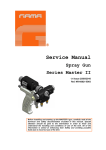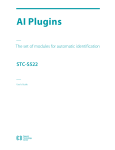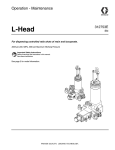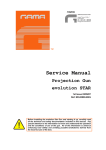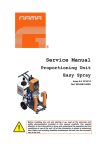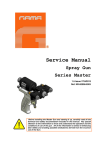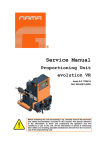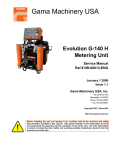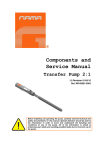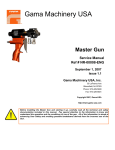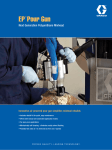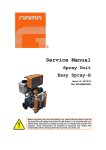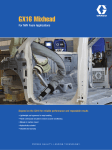Download Service Manual
Transcript
Service Manual Projection Gun G-DI Model 1.4 Issue 23/03/11 Ref. NR-00029-ENG Before installing and operating the G-DI gun, carefully read the technical and safety documentation in this manual. Special attention should be paid to the information in order to know and understand the handling and conditions of use of the Unit. All of the information is aimed at enhancing User Safety and avoiding possible faults due to incorrect use of the Unit. Service Manual WARRANTY GARRAF MAQUINARIA, S. A. (hereinafter “GAMA”) grants this LIMITED WARRANTY to the original buyer (hereinafter the “Client”) for the unit and the original accessories given with the unit (hereinafter the “Product”) against any fault in the design, materials or manufacture of the Product at the time of the first purchase by the user and for a duration of two (2) years thereafter. If during the period of guarantee and under normal conditions of use, the Product should stop working properly due to faults in the design, the materials or the manufacture, the authorised distributor in the country where the Product has been purchased or the GAMA technical service will repair or replace the Product in accordance with what is established in the following CONDITIONS a) The validity of this guarantee will be subject to the presentation of the original invoice issued by the GAMA authorised distributor for the sale of the Product along with the Product handed over for repair or replacement, which must show the date of purchase and the serial number. GAMA reserves the right to refuse to give the guarantee service when the indicated data fail to appear on the invoice or have been modified after the purchase of the Product. b) The repaired or replaced Product will continue to maintain the original guarantee during the time remaining until its end, or for three (3) months after the repair date, if the remaining period of the guarantee were shorter. c) This guarantee will not be applied to the faults in the Product caused by its faulty installation, the natural wear and tear of the components, any use other than that considered normal for this Product or which should fail to strictly comply with the instructions of use provided by GAMA; due to accident, carelessness, adjustments, alterations or modifications of the Product not authorised by GAMA or due to the use of accessories, heating devices, pumping equipment and/or dispensers that have not been approved or manufactured by GAMA. d) The guarantee applicable to the components and accessories forming part of the Product and which have not been made by GAMA will be limited to the guarantee offered by the original manufacturer thereof. GAMA WILL NOT RECOGNISE ANY EXPRESS ORAL OR WRITTEN GUARANTEES OTHER THAN THIS PRINTED LIMITED GUARANTEE. ALL IMPLICIT GUARANTEES, INCLUDING, WITHOUT LIMIT, ADAPTATION FOR A SPECIFIC USE, ARE SUBJECT TO THE DURATION OF THIS WRITTEN GUARANTEE. GAMA DOES NOT ASSUME ANY KIND OF COMMITMENT OR RESPONSIBILITY FOR ALL POSSIBLE DAMAGE OR EXPENSE CAUSED BY FAULTS IN THE OUTPUT OF THE PRODUCT, ITS WORKING OR THE DISPENSING OF MATERIAL THROUGH THE PRODUCT, INCLUDING, WITHOUT LIMITATION, ALL EXPENSES CAUSED BY DAMAGE TO PEOPLE OR PROPERTY. EQUALLY, GAMA WILL IN NO CASE ACCEPT LIABILITY FOR THE LOSS OF SPECULATIVE PROFITS OR COMMERCIAL LOSSES. ALL REPAIRS OR REPLACEMENT OF FAULTY PRODUCTS WILL CONSTITUTE THE COMPREHENSIVE FULFILMENT OF GAMA'S OBLIGATIONS WITH RESPECT TO THE CLIENT. GAMA IN NO WAY GUARANTEES THE IDEALNESS OR SUITABILITY OF ITS PRODUCT FOR ANY PURPOSE OR SPECIFIC APPLICATION. All of the information provided on components which have not been manufactured by GAMA and which is based on reports received from the original manufacturer, though considered precise and reliable, is provided without any guarantee or responsibility of any explicit or implicit kind. All concession, sale or financial leasing of the Product by GAMA in no case explicitly or implicitly constitutes any authorisation, acceptance or concession for the use of any rights or patents, nor does it encourage, nurture or back their infringement. The restrictions on the guarantee suppose no limitation on the legal rights of the consumer established in applicable national legislation, nor do they affect any rights derived from the bargain and sale agreement between the consumer and supplier. 2/28 1.4 Issue Ref. NR-00029-ENG Service Manual All of the information provided in this Service Manual has been included in the confidence that it is true, although it does not constitute any responsibility or implicit or explicit guarantee. GAMA reserves the right at any time without forewarning to make all necessary improvements and modifications to this Service Manual in order to rectify any possible typographical errors, increase the information contained and enter the changes made to the characteristics and performances of the gun. SAFETY AND HANDLING This chapter contains important information on safety, handling and the use of your GAMA G-DI series gun. Before installing and operating the G-DI gun, carefully read the technical and safety documentation in this manual. Special attention should be paid to the information in order to know and understand the handling and conditions of use of the gun. All of the information is aimed at enhancing User Safety and avoiding possible faults due to incorrect use of the gun. A WARNING! establishes information for alerting you on the situations which could cause serious injury if the instructions are not followed. A PRECAUTION! establishes information which indicates how to avoid damage to the gun and how to avoid a situation which could cause minor injuries. A NOTE is relevant information on the procedure being carried out. Careful study of this manual will help you to become more acquainted with the gun and the procedures. Following the instructions and recommendations here will reduce the potential risk of accidents in installing, using or maintaining the gun, and will give you the problem-free operation for a longer time, greater output and the possibility of detecting and resolving problems quickly and simply. Keep this Service Manual for consultation and useful information at any time. If you lose the manual, ask for a new copy from your local GAMA distributor or make direct contact with Garraf Maquinaria, S. A. WARNING: The gun's design and configuration do not allow it to be used in potentially explosive atmospheres or to exceed the pressure and temperature limits described in the technical specifications of this manual. Always use liquids and solvents that are compatible with the unit. In the event of doubt, consult the GAMA technical service. 3/28 1.4 Issue Ref. NR-00029-ENG Service Manual When working with the gun, it is essential to dress suitably and use personal protection equipment, including the unlimited use of gloves, protective goggles, safety footwear and face masks. Use breathing equipment when working with the gun in enclosed or insufficiently ventilated atmospheres. The introduction and monitoring of safety measures must not be limited to those described in this manual. Before starting to use the gun, a rigorous analysis must be made of the risks derived from the products to be dispensed, the type of application and the working environment. The gun forms part of the projection equipment, which is why all safety measures must be taken that are provided for the start-up use of the equipment, in addition to all specific measures for the use of the gun. Carefully read the safety data sheet provided by your supplier to prevent any possible injury caused by incorrect handling of the raw materials and solvents used in the process. Deal with all waste caused according to current regulations. To prevent serious damage caused by the impact of fluids under pressure, never open a connection or do maintenance work on components subject to pressure until you are sure that all pressure has been eliminated. Use suitable protection when operating, maintaining or simply being in the area where the equipment is working. This includes, but is not limited to, the use of protective goggles, gloves, shoes and safety clothes and breathing equipment. The equipment includes components which reach high temperatures and may cause burns. The hot parts of the unit must not be handled or touched until they have completely cooled. To prevent serious injury caused by crushing or amputations, do not work with the equipment if the moving part safety protections are not duly installed. Make sure that all safety protections are correctly fitted after carrying out repair or maintenance work on the equipment 4/28 1.4 Issue Ref. NR-00029-ENG Service Manual CHARACTERISTICS The new G-DI gun with a mechanical self-cleaning system has been designed for professional appliers, giving a better mixing quality than any other gun on the market in applying Polyureas, chemical systems for polyurethane foaming and some two-component epoxy systems. It is exceptionally versatile. Its special configuration offers the possibility of working with flows of 0.5 Kg/minute to 18 Kg/minute and achieving different fan shapes and widths. Thus giving great precision and maximum finishing quality in “in situ” and industrial applications. The G-DI model is light, perfectly balanced and easy to maintain thanks to the new GAMA entry block, fast-connecting and disconnecting. * High-pressure internal mixture * Mechanical automatic cleaning * No solvents required * Airless spraying * Automatic greasing of the mix chamber Approximate weight: 1.4 Kg Dimensions: H 20 cm / W 10 cm / L 21 cm SPECIFICATIONS Maximum working temperature: _____________________________________ 90º C /194º F Maximum working pressure: _______________________ 270 Kgf/cm2 (26.5 MPa) / 3840 psi Minimum working pressure required: ____________________ 7 Kgf/cm2 (0.7 MPa) / 100 psi Maximum production ratio 1:1: _______________________________ 18 Kg/min / 44 lb/min Minimum production ratio 1:1: ______________________________ 0.5 Kg/min / 1.1 lb/min Opening force @ 7 Kgf/cm2: _______________________________________ 190 Kg / 364 lbf Closing force @ 7 Kgf/cm2: _______________________________________ 190 Kg / 364 lbf Approximate air consumption @ 7 Kgf/cm2 (50 cycles/min): ____________ 60 litres/minute 5/28 1.4 Issue Ref. NR-00029-ENG Service Manual GENERAL DESCRIPTION Figure. 1 For better knowledge of the elements of the G-DI gun, the main components and their description are shown. For a more precise identification, see the Components Manual ref. NR00028. 1. 2. 3. 4. 5. 6. 7. 8. 9. 10. 11. 6/28 Mixhead Polyol side cartridge unit Iso side cartridge unit Block fixture bolt Polyol manual valve Isocyanate manual valve Entry block fixture bolt Trigger Air flow regulator Safety device Needle adjustment nut blocking screw 1.4 Issue Ref. NR-00029-ENG Service Manual Before continuing with the following procedures, familiarise yourself with the parts of the mix head, so that you know the part referred to when you read this manual. Figure .2 1. 2. 3. 4. 5. 6. 7. 8. 9. 10. 11. 12. 13. 14. 15. Cartridge housing Cartridge seal Filter Non-return Diffuser PCD nut PCD Module nut Mixing module Entry block seals Coupling block Rear closing seal Rear closing seal nut Needle Needle adjustment nut 7/28 1.4 Issue Ref. NR-00029-ENG Service Manual INSTALLATION AND START-UP PRECAUTION: When working with the gun or doing maintenance on it, all suitable protection must be used in accordance with the recommendations and specifications given by the product suppliers. GAMA provides a series of tools and accessories that are necessary for assembling the gun (KT-00004-00). The unit comprises the following elements: Metal brush (KT-00013-01), tube spanner (KT-00013-02), chuck (KT-00013-09), pliers for seeger rings DIN 472 (KT-00013-04), sockets (HT-00038/39/40/41/42/43), set of Allen keys (KT-00011-06), grease tube (OR-00012), pipe for air connection (MA-00027), fast plug (RA00109), fast plug pin (RA-00110), drills for cleaning (see Components Manual), Service Manual (NR-00029) and Components Manual (NR-00028). 1. Completely close the manual valves by turning them clockwise. The manual valves control the input flow of each product to the chamber and are located on the Coupling Block. 2. Connect the air supply pipe to the connector at the rear of the gun. 3. Connect the Isocyanate hose (red terminal) to the Isocyanate input connector (letter A) on the Coupling Block. 4. Connect the Polyol hose (blue terminal) to the Polyol input connector (letter R) on the Coupling Block. Figure .3 8/28 1.4 Issue Ref. NR-00029-ENG Service Manual NOTE: The product hoses have been distinguished with red and blue in order to allow them to be rapidly identified. The red corresponds to the Isocyanate hose and the blue corresponds to the Polyol hose. However, to avoid connection errors, the coupling connectors of the Isocyanate and Polyol hoses are of different sizes to make it impossible to swap the connections. 5. 6. 7. Open the manual air valve. Pressurise the unit and make sure there are no leaks in the gun. Squeeze the trigger several times to make sure the needle moves correctly. NB: The G-DI Gun gives an excellent mixing quality and a perfect fan, when the remains of the two mixed chemical products are totally eliminated from the mix chamber with the self-cleaning needle. It is absolutely essential that when the needle closes, it makes perfect contact with the internal spherical surface of the PCD. To achieve a suitable contact, the G-DI Gun has an adjustment system. Pay special attention when adjusting, for excessive contact can cause early wear and damage to the needle. Little contact can leave product remains in the cavity, causing incorrect mixture and fan deformation. The approximate size that should protrude from the needle tip module (measurement ”A” dimension) is 2.2 mm for 0.98 and 2.4 mm for 1.25 (see Figure. 4). Figure. 4 8. Figure .5 Adjust the needle in the firing position as indicated in the following: a. Unscrew the Needle Regulation Nut Blocking Screw by turning it anti-clockwise as show the Figure .5. 9/28 1.4 Issue Ref. NR-00029-ENG Service Manual b. Take the socket and turn the nut (anti-clockwise to move the needle forward, and clockwise to move it back. Squeeze the trigger of the gun every time you are going to turn the adjustment nut. This will make it easier to turn the nut. c. With the needle adjusted, turn the blocking screw clockwise to block the nut once more. Figure. 6 9. Make sure that the pressure in the machine and the temperature of the heaters and the hoses are correct (see the Machine Service Manual). 10. Completely open the manual valves of each product by turning them anti-clockwise. 11. Press the safety device and turn it anti-clockwise to set it to the working position. NB: The G-DI Gun has two positions, one for standstill or blocking and the other for working. In the standstill position, the needle is drawn back, but still blocks the chemical product outlet holes. In the working position, the needle is drawn back, leaving the product holes free. Figure. 7 10/28 Figure. 8 1.4 Issue Ref. NR-00029-ENG Service Manual When it stops projecting, always turn the safety device to the blocking position to avoid any kind of accidental damage when handling the gun. 12. Check the air regulator. Turn it anti-clockwise for an airflow that cleans any remains of product that might be at the tip of the PCD and on the needle. Excessive air will distort the projection fan. To completely close the air, turn it clockwise. 13. Carry out a test projection in a vessel. WARNING: Before doing maintenance, repair or cleaning work, press the safety device and turn it clockwise to leave it in blocking position, always remove the Coupling Block from the gun, completely close the manual product input valves and disconnect the air supply to avoid any possible accidents. STOPPING METHOD When stops are made of over 30 minutes, the non-return units of each product must be checked and cleaned, as well as the filters, chamber and PCD. (See the Maintenance section on page 17). Perform the following steps to ensure correct operation: 1. Perform the Unit Standstill Method with the procedure indicated in the Machine Service Manual. 2. Completely close the manual valves of each product by turning them clockwise. 3. To eliminate the pressure from the gun, press the trigger and project with the gun until the projection fan begins to narrow. 4. Press the safety device and turn it clockwise to leave it in standstill or blocked position (see Figure. 8, page 10). 5. Remove the coupling block from the gun. Use a cloth dampened with solvent to clean the contact surfaces and the seals of the coupling block. 6. Remove the non-return unit and filter from the Polyol side on the mixing block. Clean the unit with gun-cleaning solvent and also the block housing (see Figure. 19, page 18). 7. Remove the non-return unit and filter from the Isocyanate side on the mixing block. Clean the unit with gun-cleaning solvent and also the block housing (see Figure. 19, page 18). 8. Remove the filters. Clean them carefully with gun-cleaning solvent, making sure that the mesh is completely free of product remains. Clean and dry the housing well. PRECAUTION: To avoid spilling the rest of the product which has accumulated in the side cartridges onto the floor, always remove the coupling block and the side cartridges on a waste vessel. 11/28 1.4 Issue Ref. NR-00029-ENG Service Manual 9. Remove the diffuser and the PCD nut, turn them anti-clockwise with your hand and clean them with gun-cleaning solvent (see Figure. 9). 10. Remove the PCD and clean it with gun-cleaning solvent (see Figure. 10). Pay special attention in cleaning the interior spherical area. To facilitate the removal of the PCD, squeeze the gun trigger 2 or 3 times. If it can not be removed by hand, use some pliers to hold it and pull it out. Figure. 9 Figure. 10 11. Unscrew the module tightening nut by turning it anti-clockwise. 12. Remove the mixing module from its housing and clean it with gun-cleaning solvent If the product holes are blocked, clean them with the drills supplied along with the module (see Figure. 11). Clean the conic housing of the module on the head using paper dampened with gun-cleaning solvent. Do not use metal elements to clean the conic housing, a scratch on the surface could cause it to close badly with the module and this might cause leaks of the chemical products. To facilitate the removal of the module, squeeze the gun trigger 1 or 2 times for the needle to move back and forward. This movement will enable the module to be removed from its conic housing. Now pull on it with your hand to remove it from the needle. Figure. 11 13. Clean the part of the needle that protrudes from the mixhead with a paper dampened with gun-cleaning solvent. 14. Refit all of the components and put the coupling block in the gun. The gun is ready to go back into operation. 12/28 1.4 Issue Ref. NR-00029-ENG Service Manual At the end of the working day, the state of the needle must be checked (See the Maintenance section). Complete steps “1” to “11” above and perform the following operations: 1. 2. 3. Remove the safety device by pressing it and turning it anti-clockwise. Remove the spring in the head of the pneumatic cylinder (see Figure. 12). Turn the closing seal nut anti-clockwise until it no longer presses on the seal (see Figure. 13). Figure. 12 4. Figure. 13 Insert the end of the socket wrench into the hexagon of the needle and insert a socket in the hexagon of the plunger shaft to prevent it from turning (see Figure. 14 and Figure. 15). Turn anti-clockwise until the needle is completely removed from its housing. Figure. 14 13/28 Figure. 15 1.4 Issue Ref. NR-00029-ENG Service Manual 5. 6. 7. 8. Remove the needle and make sure there are no solid parts adhered to the needle, clean with gun-cleaning solvent. Loosen the rear seal nut completely by turning it anti-clockwise (see Figure. 16). Clean the conic housing of the nut with paper dampened in gun-cleaning solvent. Do not use metal elements to clean the conic housing, a scratch on the surface could cause it to close badly with the module and this might cause leaks of the chemical products. Remove the rear closing seal and clean it with gun-cleaning solvent or replace it if it is very worn (see Figure. 16). Clean the conic housing of the seal on the head using paper dampened with gun-cleaning solvent. Do not use metal elements to clean the conic housing, a scratch on the surface could cause it to close badly with the module and this might cause leaks of the chemical products. Figure. 16 9. Refit all of the components and put the coupling block in the gun. The gun is ready to go back into operation. 14/28 1.4 Issue Ref. NR-00029-ENG Service Manual INSTALLATION OF THE MIXING MODULE AND PCD 1. Put the gun in a support or a vice where it can be held firmly, to be able to clean it with your two hands without it moving. 2. Make sure that the conic housing of the mix head is clean and that its surface is not damaged. 3. Put “GAMA” grease on the threads of the tightening nut of the module and in the threaded housing of the mix head. 4. Insert the module on the tip of the needle, bearing in mind that the metal positioning pin is in line with the non-turning hole of the mix head. 5. Press the front of the mixing module with your hand while squeezing the trigger for the needle to move back. 6. The module positioning pin must have been inserted in the non-turning hole of the mixhead. 7. Without releasing the trigger, fit the tightening nut of the module, turning it clockwise. 8. Screw on the nut by hand as far as possible. Now using a socket, tighten the nut clockwise. Release the trigger and make sure the needle moves forward. Squeeze the trigger 2 or 3 times to make sure that the needle moves backward and forward correctly. 9. Make sure that the rear closing seal nut it tight, if not, turn it clockwise. BEWARE: Take special care when tightening the module and the rear closing seal nuts with a socket. Excessive tightening could mean that the pneumatic cylinder will not have sufficient force to be able to move the needle. If it is too loose, it might cause leakage from the mixing module. 10. Place the PCD in the module and press until the interior side comes into contact with the front of the module. If you have fitted a PCD for a flat fan, remember to turn the groove to the preferred projection position (see Figure. 17 and Figure. 18). Figure. 17 15/28 Figure. 18 1.4 Issue Ref. NR-00029-ENG Service Manual 11. Hand tighten the tightening nut of the PCD, clockwise. Make sure the groove does not move out of position while tightening. 12. Adjust the needle as indicated in point 8 of Installation and Start-up (see page 9). 13. Hand fit the diffuser, turning it clockwise 14. Follow the instructions of points 9 to 13 of the Installation and Start-up (see page 10 and page 11). 16/28 1.4 Issue Ref. NR-00029-ENG Service Manual MAINTENANCE To get the most out of your G-DI gun, certain periodical maintenance operations must be carried out. Carefully read the safety data sheet provided by your supplier to prevent any possible injury caused by incorrect handling of the raw materials and solvents used in the process. Deal with all waste caused according to current regulations. To prevent serious damage caused by the impact of fluids under pressure, never open a connection or do maintenance work on components subject to pressure until you are sure that all pressure has been eliminated. Use suitable protection when operating, maintaining or simply being in the area where the equipment is working. This includes, but is not limited to, the use of protective goggles, gloves, shoes and safety clothes and breathing equipment. The equipment includes components which reach high temperatures and may cause burns. The hot parts of the unit must not be handled or touched until they have completely cooled. To prevent serious injury caused by crushing or amputations, do not work with the equipment if the moving part safety protections are not duly installed. Make sure that all safety protections are correctly fitted after carrying out repair or maintenance work on the equipment 17/28 1.4 Issue Ref. NR-00029-ENG Service Manual Side cartridge unit WARNING: Before carrying out maintenance work on the gun, make sure that the unit has been completely stopped, that all of the push buttons and the main switch are turned off and that the unit is disconnected from the main power supply. The gun is a component which works under pressure. No connection must be opened or maintenance work be done on component subject to pressure until the pressure has been completely eliminated. 1. Perform the Unit Standstill Method with the procedure indicated in the Machine Service Manual. 2. Completely close the manual valves of each product by turning them clockwise. 3. To eliminate the pressure from the gun, press the trigger and project with the gun until the projection fan begins to narrow. 4. Disconnect the air supply from the gun. 5. Press the safety device and turn it clockwise to leave it in blocked position (see Figure. 8, page 10). 6. Unscrew the Isocyanate side cartridge by turning it anti-clockwise, remove it from its housing (see Figure. 19). Clean the housing with gun cleaning solvent and make sure no loose particles remain inside. 7. Remove the non-return unit and clean it with gun-cleaning solvent. 8. Remove the filter and clean it with gun cleaning solvent. 9. Make sure the mesh filter is not obstructed. If you see that the mesh is obstructed over more than 20% of its surface, replace it. 10. Make sure the holes of the filter holder cartridge are not blocked by remains of crystallised product. If you should see any dirt, clean the communicating drill holes with a drill and a brass brush. Figure. 19 18/28 1.4 Issue Ref. NR-00029-ENG Service Manual PRECAUTION! Use wooden or plastic utensils or a brass brush for cleaning. Do not use metal utensils that can scratch the surface. 11. Check the cartridge seal. Replace it if it is worn or damaged. 12. Grease all of the components and refit them in the cartridge. 13. Screw the isocyanate cartridge unit into its housing until it blocks. Make sure it is correctly tightened to avoid product leaks. 14. Do the same with the polyol cartridge. 15. Carry out the projection procedure indicated in the section on Installation and Start-up (see page 8). 16. Start the gun. 19/28 1.4 Issue Ref. NR-00029-ENG Service Manual Gun block unit, mixing module and needle WARNING: Before carrying out maintenance work on the gun, make sure that the unit has been completely stopped, that all of the push buttons and the main switch are turned off and that the unit is disconnected from the main power supply. The gun is a component which works under pressure. No connection must be opened or maintenance work be done on component subject to pressure until the pressure has been completely eliminated. Figure .20 To remove the mixing block, mixing module and needle, do the following: 1. 2. 3. Perform the unit Stopping method with the procedure given in the Machine Service Manual. Completely close the manual valves of each product by turning them clockwise. To eliminate the pressure from the gun, press the trigger and project with the gun until the projection fan begins to narrow. 20/28 1.4 Issue Ref. NR-00029-ENG Service Manual 4. 5. 6. Press the safety device and leave it in blocked position. Remove the coupling block. Use a cloth dampened with solvent to clean the contact surfaces and the seals of the coupling block. PRECAUTION: To avoid spilling the rest of the product which has accumulated in the side cartridges onto the floor, always remove the coupling block and the side cartridges on a waste vessel. 7. 8. 9. 10. 11. 12. 13. Remove the diffuser and the PCD nut by turning them anti-clockwise with your hand and clean them with gun-cleaning solvent (see Figure. 9 page 12). Remove the PCD and clean it with gun-cleaning solvent (see Figure. 10 page 12). Pay special attention in cleaning the interior spherical area. To facilitate the removal of the PCD, squeeze the gun trigger 2 or 3 times. If it can not be removed by hand, use some pliers to hold it and pull it out. Unscrew the module tightening nut by turning it anti-clockwise (see Figure. 11 page 12). Remove the mixing module from its housing and clean it with gun-cleaning solvent (see Figure. 11 page 12). If the product holes are blocked, clean them with the drills supplied along with the module. Clean the conic housing of the module in the head with paper dampened in gun cleaning dissolvent. Do not use metal elements to clean the conic housing, a scratch on the surface could cause it to close badly with the module and this might cause leaks of the chemical products. To facilitate the removal of the module, squeeze the gun trigger 1 or 2 times for the needle to move backwards and forwards. This movement will enable the module to be removed from its conic housing. Now pull on it with your hand to remove it from the needle. Disconnect the air supply from the gun. Remove the non-return and filter units of both products (see Figure. 19 page 18). Clean the non-return units and the corresponding housings with gun-cleaning solvent. Fit the non-return units, the filters, the seals and the cartridge housing in separate vessels with gun cleaning solvent. Remove the safety device by pressing it and turning it anti-clockwise (see Figure. 12, page 13). WARNING! Squeezing the trigger accidentally when the safety device has been removed from the pistol may cause serious injuries. 14. Remove the spring in the pneumatic cylinder head (see Figure. 12 page 13). 15. Turn the rear seal nut clockwise until it no longer presses on the seal (see Figure. 13 page 13). 16. Insert the tip of the socket wrench into the hexagon of the nut and insert a socket in the hexagon of the plunger shaft to prevent it from turning. Turn anti-clockwise until the needle is completely unscrewed from its housing (see Figure. 14 and Figure. 15 page 13). 17. Remove the mixing block by loosening the screw that fixes it to its support and remove the o-ring. 21/28 1.4 Issue Ref. NR-00029-ENG Service Manual 18. Completely unscrew the nut of the rear closing seal by turning it clockwise (see Figure. 16, page 14). Clean the conic housing of the nut with paper dampened in gun cleaning solvent. Do not use metal elements to clean the conic housing, a scratch on the surface could cause it to close badly with the module and this might cause leaks of the chemical products. 19. Remove the rear closing seal and clean it with gun cleaning solvent or replace it if it is very worn. 20. Clean the mixing block with gun cleaning solvent. PRECAUTION! The module and the rear seal with the mixing block are closed with a precision cone. Take particular care when cleaning these components to avoid damaging their surface finish. Use wooden or plastic utensils or a brass brush for cleaning. Do not use metal utensils that could scratch the contact surfaces. 21. Before reassembling the whole unit, it is important to make sure that all of the components are clean and free of any defect, make sure there is no damage to any of the components before continuing with the assembly. 22. Insert the rear closing seal in the mixing block and hand tighten the retention nut at the rear of the block without tightening excessively. 23. Fit the o-ring and fix the mixing block to the gun support with the bolt. 24. Insert the needle in its housing using the air cylinder piston and tighten it using the tube socket. Insert a socket in the hexagon of the plunger shaft to prevent it from turning 25. Fit the spring in the pneumatic cylinder head. 26. Fit the safety device. Press and turn the device clockwise to set it to its blocking position. 27. Fit the non-return units and the filter bolt. 28. Fix the gun in a support or a vice where it can be held firmly, to be able to handle it with your two hands without it moving. 29. Connect the air supply. 30. Put “GAMA” grease on the threads of the module tightening nut and in the threaded housing of the mixhead. 31. Insert the module on the tip of the needle, making sure the metal positioning pin is in line with the non-turning hole of the mixhead. 32. Press the front of the mixing module with your hand while squeezing the trigger, so that the needle moves back. 33. The module positioning pin must have been inserted in the non-turning hole of the mixhead. 34. Without releasing the trigger, fit the module tightening nut, turning it clockwise. 35. Tighten the nut by hand as far as you can. Now using a socket, tighten the nut clockwise. 36. Release the trigger and make sure the needle moves forward. Squeeze the trigger 2 or 3 times to make sure that the needle moves backward and forward correctly. 37. Make sure that the rear closing seal nut is tight, if not turn it clockwise with a spanner. 22/28 1.4 Issue Ref. NR-00029-ENG Service Manual WARNING: Take particular care when tightening the module nut and the rear closing seal nut with the socket. Excessive tightening can result in the pneumatic cylinder not having sufficient force to move the needle. If it is too loose, it might cause leakage from the mixing module. 38. Fit the PCD on the module and press until the interior side makes contact with the front of the module. If you have fitted a PCD for flat fan, remember to turn the groove to the preferred projecting position (see Figure. 17 and Figure. 18, page 15). 39. Fit the tightening nut of the PCD by hand, turning it clockwise. Make sure the groove does not move out of position while tightening. 40. Make sure that the length that stands out of the chamber needle is correct, otherwise it must be adjusted (see Figure. 4, page 9). Adjust the needle as indicated in point 8 of Installation and Start-up (see page 9). 41. Fit the diffuser by hand, turning it clockwise. 42. Fit the seals of the coupling block in place and fix it to the gun mixing block. 43. Follow the instructions of points 9 to 13 of the Installation and Start-up (see page 10 and 11). 23/28 1.4 Issue Ref. NR-00029-ENG Service Manual Trigger and valve WARNING: Before carrying out maintenance work on the gun, make sure that the unit has been completely stopped, that all of the push buttons and the main switch are turned off and that the unit is disconnected from the main power supply. The gun is a component which works under pressure. No connection must be opened or maintenance work be done on component subject to pressure until the pressure has been completely eliminated. Figure. 21 1. 2. 3. 4. 5. 6. 7. Remove the coupling block. Use a cloth dampened with solvent to clean the contact surfaces and the seals of the coupling block. Disconnect the air hose supply. Unscrew the trigger stop bolt (see Figure. 21). This bolt limits the trigger and also works as a stopper of the air circuit, it is important to remember it when reassembling. Remove the retention ring, the pin and the trigger (see Figure. 21). Unscrew the trigger valve nut (see Figure. 21). Remove the valve. The valve has a spring inside it, take care not to lose it (see Figure. 21). 24/28 1.4 Issue Ref. NR-00029-ENG Service Manual 8. 9. 10. 11. 12. 13. 14. 15. 16. 17. Check the valve o-rings. Replace them if they are damaged. Apply a little grease to make it easier to assemble. Make sure the housing is clean and apply a small layer of grease inside. Check the state of the spring, and replace it if it is worn. Insert the spring in the valve and the whole unit in the housing, taking special care not to damage the o-rings. You will note a certain resistance caused by the interference of the seals with the housing wall. Insert it until you see the first rows of the thread. Screw down the nut using sealing paste to avoid air leaks. Do not tighten excessively. Fit the trigger with the pin and hold it with the retention ring. Place Teflon on the tip of the bolt limiting the trigger and screw it into the handle. Fit the connection connector and the air hose to the rear of the gun. Fit the coupling block as described in the section on assembling the gun block unit and the mixing chamber. Start the gun. 25/28 1.4 Issue Ref. NR-00029-ENG Service Manual Pneumatic cylinder WARNING: Before carrying out maintenance work on the gun, make sure that the unit has been completely stopped, that all of the push buttons and the main switch are turned off and that the unit is disconnected from the main power supply. The gun is a component which works under pressure. No connection must be opened or maintenance work be done on component subject to pressure until the pressure has been completely eliminated. Figure. 22 1. Remove the safety device by pressing it and turning it anti-clockwise (see Figure. 12, page 13). WARNING! Accidentally squeezing the trigger when the gun safety device has been removed can cause serious injury. 26/28 1.4 Issue Ref. NR-00029-ENG Service Manual 2. Remove the spring in the pneumatic cylinder head (see Figure. 12, page 13). 3. Insert the end of a socket wrench in the hexagon of the needle and turn it anti-clockwise until the needle is completely unscrewed from its housing (see Figure. 14 and Figure. 15, page 13). 4. Unscrew the bolt fixing the sleeve pin at the rear of the gun (see Figure. 22, page 26). 5. Remove the retention ring that positions the cylinder head with pliers for removing seeger rings (see Figure. 22, page 26). 6. Remove the pneumatic cylinder head (see Figure. 22, page 26). 7. Check the state of the closing seal of the cylinder block. Replace it if it is damaged. Apply a little grease to make it easier to assemble. 8. Pull hard on the plunger to remove the whole unit from the cylinder sleeve. Also remove the plunger spring (see Figure. 22, page 26). 9. Check the state of the rod seals and the plunger seal. Replace any that are damaged. Apply a little grease to make it easier to assemble. 10. Refit all of the components. Figure. 23 WARNING: To guarantee the fixture of the cylinder head, make sure the retention ring is perfectly housed in the fixing groove (see Figure. 23). To avoid any possible error in assembly, avoid approaching the cylinder block when pressure is applied to the gun after performing any cleaning, repair or maintenance work. 27/28 1.4 Issue Ref. NR-00029-ENG Service Manual CONTENT Warranty ______________________________________________________ 2 Safety and Handling ____________________________________________ 3 Characteristics _________________________________________________ 5 Specifications__________________________________________________ 5 General Description _____________________________________________ 6 Installation and Start-up _________________________________________ 8 Stopping method ______________________________________________ 11 Installation of the Mixing Module and PCD _________________________ 15 Maintenance __________________________________________________ 17 Side cartridge unit _________________________________________________________ 18 Gun block unit, mixing module and needle ______________________________________ 20 Trigger and valve _________________________________________________________ 24 Pneumatic cylinder ________________________________________________________ 26 Content ______________________________________________________ 28 28/28 1.4 Issue Ref. NR-00029-ENG





























